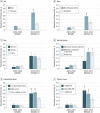Changes in US Lifetime Heroin Use and Heroin Use Disorder: Prevalence From the 2001-2002 to 2012-2013 National Epidemiologic Survey on Alcohol and Related Conditions
- PMID: 28355458
- PMCID: PMC5470460
- DOI: 10.1001/jamapsychiatry.2017.0113
Changes in US Lifetime Heroin Use and Heroin Use Disorder: Prevalence From the 2001-2002 to 2012-2013 National Epidemiologic Survey on Alcohol and Related Conditions
Erratum in
-
Error on X-axes in Figure 2.JAMA Psychiatry. 2017 Oct 1;74(10):1079. doi: 10.1001/jamapsychiatry.2017.2725. JAMA Psychiatry. 2017. PMID: 28832868 Free PMC article. No abstract available.
Abstract
Importance: Heroin use is an urgent concern in the United States. Little is know about the course of heroin use, heroin use disorder, and associated factors.
Objective: To examine changes in the lifetime prevalence, patterns, and associated demographics of heroin use and use disorder from 2001-2002 to 2012-2013 in 2 nationally representative samples of the US adult general population.
Design, setting, and participants: This survey study included data from 43 093 respondents of the 2001-2002 National Epidemiologic Survey on Alcohol and Related Conditions (NESARC) and 36 309 respondents of the 2012-2013 NESARC-III. Data were analyzed from February 2 to September 15, 2016.
Main outcomes and measures: Lifetime heroin use and DSM-IV heroin use disorder.
Results: Among the 79 402 respondents (43.3% men; 56.7% women; mean [SD] age, 46.1 [17.9] years), prevalence of heroin use and heroin use disorder significantly increased from 2001-2002 to 2012-2013 (use: 0.33% [SE, 0.03%] vs 1.6% [SE, 0.08%]; disorder: 0.21% [SE, 0.03%] vs 0.69% [SE, 0.06%]; P < .001). The increase in the prevalence of heroin use was significantly pronounced among white (0.34% [SE, 0.04%] in 2001-2002 vs 1.90% [SE, 0.12%] in 2012-2013) compared with nonwhite (0.32% [SE, 0.05%] in 2001-2002 vs 1.05% [SE, 0.10%] in 2012-2013; P < .001) individuals. The increase in the prevalence of heroin use disorder was more pronounced among white individuals (0.19% [SE, 0.03%] in 2001-2002 vs 0.82% [SE, 0.08%] in 2012-2013; P < .001) and those aged 18 to 29 (0.21% [SE, 0.06%] in 2001-2002 vs 1.0% [0.17%] in 2012-2013; P = .01) and 30 to 44 (0.20% [SE, 0.04%] in 2001-2002 vs 0.77% [0.10%] in 2012-2013; P = .03) years than among nonwhite individuals (0.25% [SE, 0.04%] in 2001-2002 vs 0.43% [0.07%] in 2012-2013) and older adults (0.22% [SE, 0.04%] in 2001-2002 vs 0.51% [SE, 0.07%] in 2012-2013). Among users, significant differences were found across time in the proportion of respondents meeting DSM-IV heroin use disorder criteria (63.35% [SE, 4.79%] in 2001-2001 vs 42.69% [SE, 2.87%] in 2012-2013; P < .001). DSM-IV heroin abuse was significantly more prevalent among users in 2001-2002 (37.02% [SE, 4.67%]) than in 2012-2013 (19.19% [SE, 2.34%]; P = .001). DSM-IV heroin dependence among users was similar in 2001-2002 (28.22% [SE, 3.95%]) and in 2012-2013 (25.02% [SE, 2.20%]; P = .48). The proportion of those reporting initiation of nonmedical use of prescription opioids before initiating heroin use increased across time among white individuals (35.83% [SE, 6.03%] in 2001-2002 to 52.83% [SE, 2.88%] in 2012-2013; P = .01).
Conclusions and relevance: The prevalence of heroin use and heroin use disorder increased significantly, with greater increases among white individuals. The nonmedical use of prescription opioids preceding heroin use increased among white individuals, supporting a link between the prescription opioid epidemic and heroin use in this population. Findings highlight the need for educational campaigns regarding harms related to heroin use and the need to expand access to treatment in populations at increased risk for heroin use and heroin use disorder.
Conflict of interest statement
Figures


Comment in
-
The Surge of Opioid Use, Addiction, and Overdoses: Responsibility and Response of the US Health Care System.JAMA Psychiatry. 2017 May 1;74(5):441-442. doi: 10.1001/jamapsychiatry.2017.0163. JAMA Psychiatry. 2017. PMID: 28355456 No abstract available.
-
Factors to Consider for Reducing US Opioid-Related Deaths: Looking Beyond Access-Reply: Factors to Consider for Reducing US Opioid-Related Deaths-Reply.JAMA Psychiatry. 2017 Nov 1;74(11):1171-1172. doi: 10.1001/jamapsychiatry.2017.2431. JAMA Psychiatry. 2017. PMID: 28903133 No abstract available.
-
Factors to Consider for Reducing US Opioid-Related Deaths: Looking Beyond Access.JAMA Psychiatry. 2017 Nov 1;74(11):1171. doi: 10.1001/jamapsychiatry.2017.2586. JAMA Psychiatry. 2017. PMID: 28903166 No abstract available.
References
-
- Han B, Compton WM, Jones CM, Cai R. Nonmedical prescription opioid use and use disorders among adults aged 18 through 64 years in the United States, 2003-2013. JAMA. 2015;314(14):1468-1478. - PubMed
-
- Darke S, Marel C, Mills KL, Ross J, Slade T, Tessson M. Years of potential life lost amongst heroin users in the Australian Treatment Outcome Study cohort, 2001-2015. Drug Alcohol Depend. 2016;162:206-210. - PubMed
MeSH terms
Grants and funding
LinkOut - more resources
Full Text Sources
Other Literature Sources
Medical

